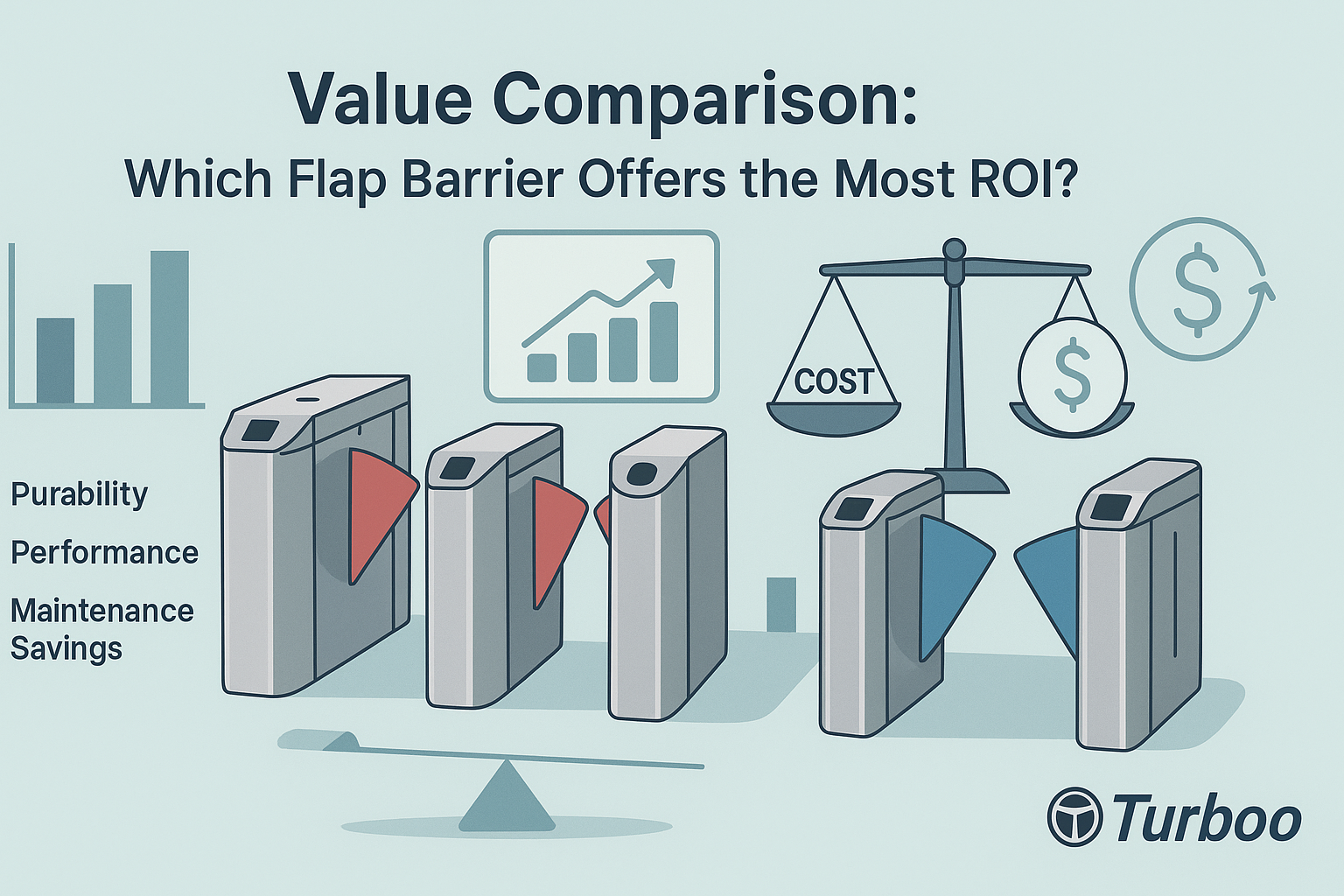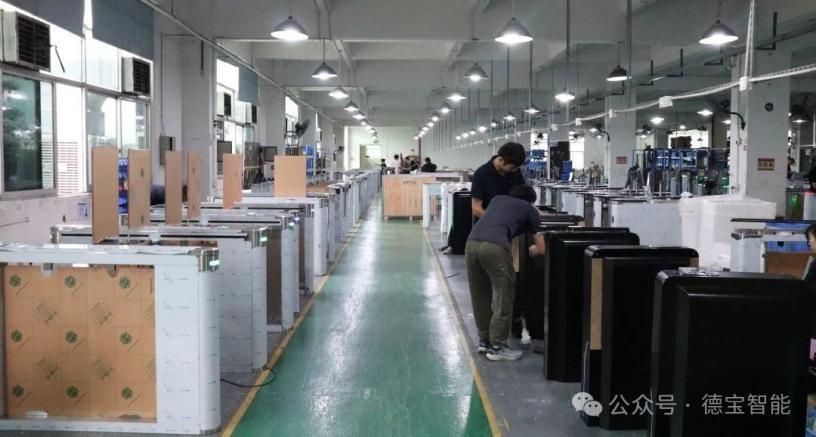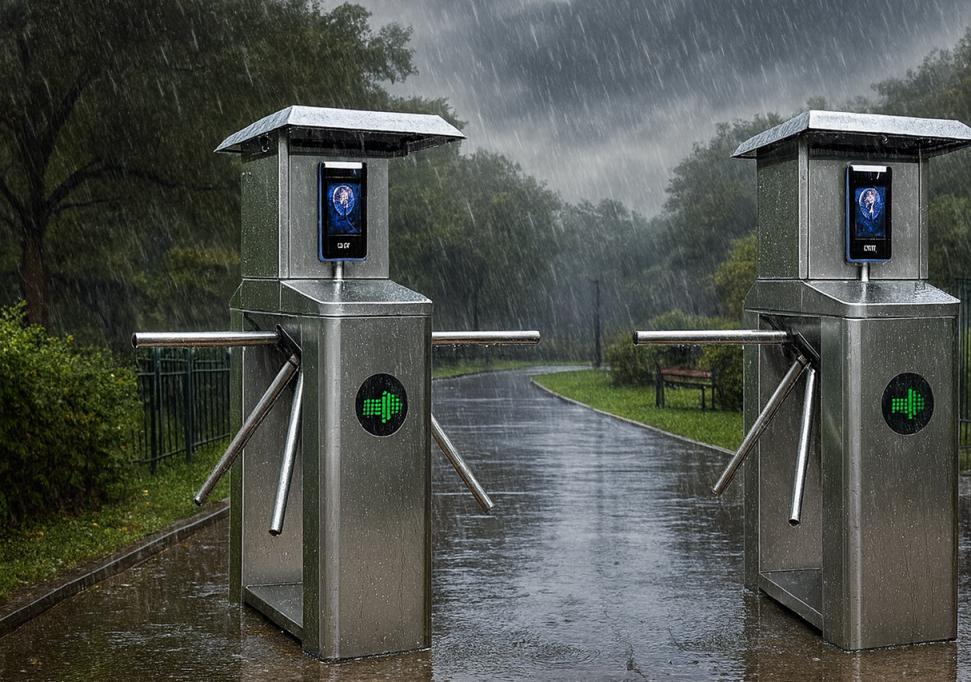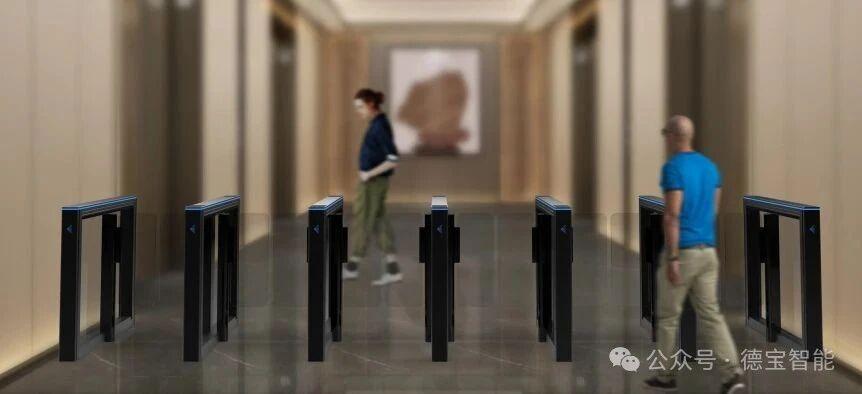Value Comparison: Which Flap Barrier Offers the Most ROI?


How do you really know which flap barrier gives you the best bang for your buck? This is one of the most common questions asked by security managers, procurement officers, and building facility leads. The market has plenty of options, and the prices vary a lot. It’s tempting to choose the lowest-cost barrier thinking it saves money upfront. But that first saving can quickly turn into unexpected repair bills, increased power costs, or even replacement needs in just a few years.
A true flap barrier value isn’t about the sticker price. It comes down to how well the system performs daily, how often it breaks, and how long it lasts before you need a new one. The value is in the return on investment, or ROI. That includes everything from how easy it is for users to pass through to how fast it gets fixed if something goes wrong. Even power bills play a role in deciding the real cost.
If you’re responsible for choosing a flap barrier system, you need more than a sales pitch. You need a clear guide on what actually makes a system worth the money. That’s what this guide delivers. You’ll learn how to compare models, see what affects ROI the most, and make better choices with your budget. Whether you’re updating an old entry point or setting up a new one, this information will help you avoid costly mistakes.
By the end, you won’t just know which model is cheaper—you’ll know which one is smarter.
Understanding Flap Barrier Value Beyond Price
It’s easy to compare two barriers by price. One costs $1,200 and the other $1,700. On the surface, it looks like the cheaper option saves $500. But what if the lower-cost barrier needs servicing every 6 months, while the other only needs yearly maintenance? What if it draws more electricity daily or lacks support when something breaks?
Flap barrier value comes from looking at the full picture. This means looking at the total cost of ownership—not just the purchase price. It includes repair costs, electricity usage, how often it malfunctions, and even how fast you can get parts or support.
For example, a budget model might need a new control board every year at $250 each time. A better-built model may not need any replacements for three years. That’s $750 in parts savings already. Add the cost of technician visits, and the numbers add up fast.
You also need to think about downtime. If your barrier is the main entry point for a school or subway station, any outage creates delays and risks. Every minute it’s down could mean long queues or even a security breach. A slightly more expensive barrier that stays operational longer ends up being a safer and more cost-effective choice.
Looking at flap barrier value as a long-term investment changes everything. You stop chasing discounts and start chasing durability and consistency. This guide will show you how.
Performance Features that Influence ROI
Performance isn’t just about speed—it’s about how well the barrier handles daily demand without failure. If a flap barrier supports 30 users per minute but you’re pushing through 45, it’s going to wear out quicker. Flap barrier performance includes user capacity, response time, and how well it works with your access control setup.
A fast system helps people move without queuing, especially during rush hour. This is crucial in metro stations, universities, or office buildings. If the barrier lags or misreads cards, users get frustrated. That slows down operations and hurts the experience.
Another key area is compatibility. Your flap barrier needs to work with your existing systems, like RFID readers, fingerprint scanners, or QR code terminals. If it doesn’t support these, you’ll spend more on adapters—or worse, end up replacing the whole setup.
Some models are also built with tougher internal components. Motors, for instance, can vary widely. Cheap units might burn out in 12 months under heavy use, while higher-end models run smoothly for years. Materials also matter. Barriers with stainless steel arms and industrial-grade plastics stand up better over time than thinner or poorly finished units.
Want a deeper dive on how to judge performance? Check this out: Flap Barrier Performance
The smarter choice is always the one that performs at the level your site demands—day in, day out.
Maintenance Frequency and Part Costs
Every machine breaks eventually. The difference is how often it breaks and how much it costs to fix. Low-cost flap barriers often have short maintenance cycles. Some require technician visits every 6 months just to stay operational. That adds labor costs, especially if your site uses third-party technicians.
Spare parts are another big factor in your ROI. If replacement arms, sensors, or control panels are expensive or hard to source, your costs rise and your downtime increases. On the flip side, some barrier systems are modular. That means parts are easy to swap out and widely available, keeping repair costs lower and service faster.
For example, one brand may charge $80 for a basic replacement sensor, while another charges $160. Multiply that by four units, and the maintenance difference becomes significant. And if your supplier doesn’t offer fast shipping or local support, you’ll wait days or weeks with a barrier that doesn’t work.
Maintenance frequency directly affects your total cost of ownership. Systems that run longer between services and use affordable parts deliver higher ROI over time. Always ask about average service intervals and part pricing when comparing options.
Power Usage and Operational Efficiency
Power consumption might seem like a small thing at first, but it adds up—especially in high-traffic locations. A flap barrier runs on electricity 24/7. Even a small difference in wattage can turn into hundreds of dollars in electricity over a year.
Some older models use more power because of outdated motors or inefficient standby modes. Newer models often come with energy-saving designs. These use less power when idle and only ramp up during active use. Over a 5-year lifespan, that savings can be noticeable on your facility’s utility bill.
If your building has green goals or is working toward energy certifications, power use matters even more. Choosing a barrier that meets those goals not only supports your environmental goals but also boosts your ROI by lowering operating costs.
For those interested in broader security solutions that consider energy efficiency as part of value, you can explore more at HID Security Solutions.
Ease of Use for Staff and Visitors
When you’re evaluating flap barrier value, it’s easy to overlook usability. But the more intuitive a system is, the fewer problems you’ll have—both for visitors and staff. Think about how many different users pass through a barrier every day. If the process is confusing or error-prone, it creates bottlenecks, frustration, and sometimes security risks.
Usability isn’t just about screen prompts or voice alerts. It’s about the flow. A good flap barrier guides users naturally. People shouldn’t have to wonder where to tap their card or which direction to walk. When the system is simple, even first-time visitors can pass through without help. That reduces staff involvement and makes your site run more smoothly.
Also, consider how staff interact with the system. Can your security team easily reset or override it when needed? Can they see errors in real time and take action? A system that’s easy to control gives your team more confidence and control.
User experience has a direct effect on ROI. A barrier that causes fewer entry mistakes or system lockups saves time. It keeps your personnel focused on bigger tasks and helps traffic flow consistently during peak hours.
Systems that combine smooth movement, clear signals, and consistent user behavior lead to fewer incidents and higher value over time.
Reliability and Downtime Considerations
Flap barrier reliability may be one of the most important ROI factors of all. When a barrier breaks down—even briefly—it disrupts everything. People are delayed. Security is weakened. Staff are pulled away from their duties to manually manage traffic or troubleshoot issues. Over time, these disruptions carry real financial and operational costs.
A reliable flap barrier stays operational even under pressure. This means consistent performance during high traffic, resistance to minor electrical issues, and strong resilience to environmental wear—especially in dusty or humid climates.
Some cheaper barriers use less durable motors or lower-grade circuit boards. These can handle light use but start failing when traffic gets heavy. That failure rate hurts your ROI. Even if repairs are cheap, the downtime costs your team more in lost productivity.
Reliability is also about performance during off-hours. If your system is part of a 24/7 facility—like a hospital or transit station—it needs to work round the clock. A unit that fails at midnight may not get fixed until morning. Every minute offline increases the risk of unauthorized entry.
That’s why it’s smart to ask vendors for uptime statistics and average time-between-failure rates. A 99.9% uptime might sound similar to 98%, but in a busy facility, the difference adds up. The more reliable the barrier, the less you spend fixing problems, and the higher your overall ROI.
Brand Reputation and Support Services
Flap barrier value isn’t just about hardware—it’s about who stands behind it. A trusted brand means better engineering, but more importantly, it usually means better support. That matters when things go wrong.
When your barrier needs service, how quickly can the supplier respond? Do they offer remote troubleshooting? Can you get parts locally or will they need to ship from overseas? A vendor with good support will help you avoid long delays and costly downtime.
Reputable brands often come with clear documentation, training resources, and accessible customer service. That makes your team’s job easier and speeds up issue resolution. If you have a large site, or several locations, global brands may offer integrated support plans. But don’t discount local providers—they often offer faster response times and more personalized service.
The brand’s track record also signals product quality. If the company has been in the business for years and has major clients, it shows they’ve tested their products in different environments. That’s valuable information when estimating your ROI.
So when comparing entry systems, look at more than just the device. Look at the team behind it. A good support network can often be the difference between a minor glitch and a major disruption.
Warranty Terms and What They Cover
Not all warranties are created equal. Some cover just a few components for a year. Others offer full system protection for two or even three years. When thinking about ROI, the warranty gives you a safety net that affects your future spending.
Start by checking how long the warranty lasts. Then look closely at what’s included. Does it cover motors, circuit boards, or only structural parts? Are technician visits included? What’s the response time for a warranty claim?
Some companies offer extended warranties or service contracts at a cost. While these add to the initial purchase price, they can reduce your long-term risk. For example, a two-year extended warranty might cost $200 per unit but save thousands if a major part fails unexpectedly.
Also, consider how easy it is to claim the warranty. If the process is slow, complex, or limited by geographic restrictions, your system might be down longer than expected. A reliable vendor makes claims simple and quick.
The best warranties act as a buffer between your team and unexpected expenses. They protect your investment and ensure consistent performance over time. Always factor warranty terms into your barrier ROI.
Upgrade Potential and Future-Proofing
The best flap barrier isn’t always the one with the most features today—it’s the one that can grow with your needs tomorrow. Technology moves fast. If your barrier system can’t adapt, you’ll be forced to replace it sooner than expected. That shortens its value lifespan and cuts into your ROI.
Some barriers come with modular designs. That means you can add new access options—like facial recognition, mobile pass readers, or improved safety sensors—without replacing the whole unit. This flexibility keeps your infrastructure current and spreads the cost over time.
Upgrading also includes software. Can the barrier’s firmware be updated remotely? Can it integrate with changing security systems or cloud access platforms? The more adaptable your system, the longer it stays useful.
This is especially true in sectors like corporate offices and universities, where security demands evolve. A barrier that accepts upgrades will give you more return on your long-term barrier investment.
Want help comparing all these elements from price to features? Use this resource: Flap Barrier Buying Guide
Comparing Supplier Track Records
The supplier you choose can make or break the long-term value of your flap barrier system. It’s not just about getting the product delivered. It’s about having someone reliable on the other end when issues pop up—whether that’s a technical failure, an installation hiccup, or a question about upgrades.
A good supplier has a clear track record. That means they’ve sold to similar industries, maintained solid relationships, and offered consistent post-sale support. Before making a purchase, check their customer reviews, ask for client references, and look at their case studies. Suppliers who have long-standing contracts with government agencies, transport hubs, or global companies tend to be more dependable.
The ability to deliver parts quickly is also a sign of a strong supplier. If they keep parts in local stock or have regional service centers, that shortens your downtime in case something breaks. Some even offer on-site training and remote diagnostics—things that increase the practical value of your investment.
Look out for red flags too. If the supplier dodges your questions, doesn’t provide clear service agreements, or lacks documentation, that’s a warning sign. A weak supplier relationship leads to higher costs over time and damages your expected ROI.
Choosing a flap barrier is not just about the product—it’s about the partner. A reliable supplier supports your goals, not just their sale.
Use Case: High-Traffic Locations
When flap barriers are installed in places like subway stations, airports, or universities, the stakes are higher. These environments often see thousands of people a day. The barrier must operate at full capacity without constant resets, maintenance, or failures.
In these cases, barrier ROI isn’t just a theory—it’s real and visible in day-to-day operations. A cheaper unit might start to struggle under load after just a few months. It may jam more often, require more frequent part changes, or just wear out faster. Each breakdown adds labor costs and causes delays.
Some high-traffic sites end up replacing barriers every 2–3 years because the systems weren’t designed for that level of use. On the other hand, models designed for industrial throughput might last 5–7 years with fewer service interruptions. That extra lifespan, combined with reduced repair frequency, often justifies the higher purchase cost.
Speed also matters. Delays of just a few seconds per person add up fast in a crowded setting. A flap barrier with faster read times and smoother opening can shave valuable minutes off rush hour backups. This kind of performance-driven design adds measurable ROI through improved efficiency and customer satisfaction.
When comparing options, always match the barrier to your traffic level. In high-use environments, the barrier’s true value shows up every single day.
Use Case: Office Buildings and Secure Facilities
Office buildings and secured corporate spaces need a different kind of flap barrier value. Here, the focus shifts slightly. While high throughput is still important, appearance, access control compatibility, and data tracking become even more critical.
These sites often require integration with employee badges, biometric scanners, or visitor management systems. A low-end barrier may not support all these options or may require expensive adapters. Investing in a system with native integration support saves money and avoids future headaches.
Appearance also matters more in these settings. The flap barrier becomes part of the space’s first impression. Cheap or bulky units may feel out of place in a modern lobby. Higher-quality models often include customizable finishes, glass arms, or stainless steel exteriors that blend into the space.
Security is also more tightly controlled. The barrier must reject unauthorized entries reliably, log every access attempt, and alert staff to anomalies. These advanced features come with a higher price tag—but they also reduce the need for manual security interventions, which saves money long term.
And don’t forget remote management. Many high-end office buildings prefer barriers that can be monitored and controlled from a centralized dashboard. That’s an added convenience that boosts operational ROI.
When aesthetics and integration matter just as much as function, choosing a higher-end model delivers more long-term value.
Real-Life Comparisons and What They Reveal
Let’s say you’re comparing two popular flap barrier models. Model A costs $1,200. Model B costs $1,800. At first glance, Model A seems like the smarter buy. But look closer.
Model A has an average maintenance cycle of 6 months, with a $150 part replacement needed annually. It also consumes more power, adding $80 per year in energy costs. Downtime across the year averages 20 hours, requiring at least 2 technician visits.
Model B, while more expensive up front, has a 12-month maintenance cycle and rarely needs part replacements. It uses less energy, saving $50 a year. Its uptime is higher—only about 4 hours of service disruption per year, thanks to better components and remote monitoring.
After 3 years, Model A ends up costing $2,100, while Model B costs $1,950. And that’s just the money. Model B also caused fewer delays, needed less staff time, and performed better under stress.
This is where barrier ROI becomes obvious. A higher price doesn’t always mean lower value. When you account for performance, maintenance, energy, and support, sometimes the more expensive unit is actually the cheaper one over time.
Looking for price comparisons? Here’s a helpful resource: Flap Barrier Price Comparison
Checklist: How to Compare Flap Barrier ROI
- Initial cost of the barrier
- Warranty length and what’s covered
- Maintenance cycle (how often service is needed)
- Cost and availability of spare parts
- Energy consumption and monthly power usage
- Uptime percentage and known downtime issues
- User capacity and speed of operation
- Compatibility with access control systems
- Ease of use for staff and visitors
- Remote monitoring and software upgrade support
- Supplier support responsiveness
- Availability of local service and spare parts
- Upgrade potential (modular or fixed)
- Long-term use cases from other clients
Final Thoughts
Picking the right flap barrier isn’t about finding the lowest price tag. It’s about asking the right questions. Can the unit handle your traffic levels? Will it hold up over years of use? Are repairs easy, fast, and affordable? And does the supplier stand by the product when you need them most?
Flap barrier value is best measured over time. The cheapest option might cost you more through downtime, repairs, or power bills. The smartest choice is the one that balances upfront investment with lower operating costs and longer service life.
This guide has walked you through the key elements—from performance and maintenance to brand support and warranty terms. Use this information to make better buying decisions that protect your budget today and tomorrow.
FAQs
1. What does flap barrier ROI mean in simple terms?
It’s how much value you get from a flap barrier over time. It includes costs like power, repairs, and downtime—not just the purchase price.
2. Why do cheaper barriers sometimes cost more in the long run?
They often need more repairs, use more power, or break down faster. Those ongoing costs can add up quickly.
3. How do I know if a barrier is right for high-traffic areas?
Look at user capacity, uptime, and maintenance cycles. The best models for busy places are built for durability and speed.
4. What should I ask a supplier before buying?
Ask about warranty terms, support services, spare parts availability, and integration with your current systems.
5. Can I upgrade my flap barrier later?
Some models are modular and allow for future upgrades like biometric access. Others are fixed, so check before buying.












